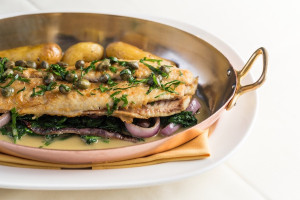Meat Glue Mania: Highlights from Wylie Dufresne's Harvard Lecture
Last night, chef Wylie Dufresne of famed New York avant-garde restaurant wd~50 was the latest bigwig toque to take the stage at Harvard to talk science and food. While past topics have included mouthfeel and gelation, this time the talk centered on the enzyme transglutaminase, more commonly known as “meat glue” (in Dufresne’s words,“[Meat glue] sounds cooler, and a lot more evil.”).
After his lecture, we sat down with Dufresne to chat. While the chef is a New Yorker now, he has New England roots; he grew up in Providence and went to Colby College in Maine (irrelevant fun fact: at Colby, he failed to make the soccer team in such an epic fashion that there’s still a drill in place there dubbed “Wylie shooting.”) Despite the northern background, Dufresne isn’t a frequent Boston visitor — though he did tell us that after his lecture, he planned to fuel up on tapas at Toro.
Without further ado, we present Meat Glue: The Takeaway. For even more of what you missed, check out our slide show above.
Transglutaminase, or “meat glue,” is all natural, baby.
While there’s been much ado about modernist chefs using chemicals to alter their food, transglutaminase is actually a naturally occurring enzyme. In fact, we even have it in our own bodies. In order for the enzyme to bind proteins, two amino acids need to be present: lysine, and glutamine. Because of this, meat glue works best with meat and fish (in the slide show above, see how the addition of gelatin makes it possible to bind things like nuts and veggies).
Dufresne’s not trying to contradict nature, he’s just trying to improve it a bit.
By gluing together thin stacks of flap steak or lamb skirt steak, which often quickly overcook, Dufrense is creating entirely new desirable portions of meat out of less expensive cuts. “I’m not saying nature is wrong, but sometimes it’s not convenient,” Dufresne says. “It’s not like I am trying to create a jackalope, although that would be pretty cool.” By gluing scrap cuts (that would normally be tossed) of meat or fish together for properly portioned pieces, Dufresne also minimizes waste.
Chicken skin pairs well with everything.
Though Dufresne says he has to be cautious when gluing different meats together (duck + lobster, for example, can make for textural problems), chicken skin works with everything. He mentioned gluing the skin to salmon, and says he also likes to wrap it around shrimp. While putting fish skin on poultry has proven less appealing to diners, he says it’s a delicious combo as well.
With great meat glue comes great responsibility.
An audience member asked Dufresne if there’s an increased risk for spreading bacteria when using meat glue, since technically the meat surfaces are turned inward before cooking. Dufresne admitted that while it’s a risk, it’s no more so of one than, for example, searing ground meat for burgers. “You are assuming a lot more risk letting your average, or sub-average sushi guy handle your sushi before he puts it into a to go container and sends it to you,” Dufresne says. But he says his kitchen staff is incredibly diligent.
Want to try it at home? Go right ahead.
Turns out, you can order meat glue on Amazon.com (it’s about 100 bucks for a two-pound bag). For proper storage, Dufresne recommends keeping it in the freezer.
For more online food coverage, follow us on Twitter @ChowderBoston


